Scientific classification
Kingdom:
Phylum:
Echinodermata
Class:
Crinoidea
Order:
Comatulida
Family:
Antedonidae
Genus:
Antedon
Species:
A. Bifida
Binomial name (link Wikipedia)




Atlantic Feather Star
Comatule
Atlantischer Haarstern
Comátula
Zeelelie
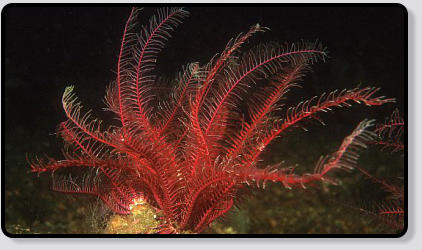
Description
Antedon bifida is a species of crinoid in the family Antedonidae commonly known as the rosy feather star. It is found in north west Europe.
The body of A. bifida is a concave disc surrounded by ten pinnately divided arms giving it a fern-like appearance. The mouth and ambulacral
grooves are on the upper surface of the disc. The arms can be up to 10cm (4in) long but are usually shorter than this. The undersides of the
arms have prominent transverse ridges and some have modifications for feeding and reproduction. The pinnules are jointed, have about 35
segments and bear unequal sized tube feet in groups of three. The arm colour is variable, ranging from yellow or pink to deep purple, sometimes
spotted or blotched, and the pinnules are usually paler or white. There are about twenty short cirri, banded and arranged in transverse rows on a
central raised ossicle. These curl under and grasp the surface enabling the animal to crawl around which it can do with great rapidity. It may be
confused with the rather similar Antedon petasus but that species is usually larger with up to 50 cirri, looks neater and does not have ridges on
the undersides of its arms.
A. bifida is primarily found on the coasts of north west Europe, the range extending from the Shetland Islands south to Portugal. It has also been
reported from Algeria, Tunisia, West Africa and Venezuela. Around the British Isles it is found on north eastern and on western coasts. It occurs
from the low tide mark to a depth of about 200m (650ft) and occasionally much deeper.

Animalia
Scientific classification
Kingdom:
Phylum:
Echinodermata
Class:
Asteroidea
Order:
Paxillosida
Family:
Astropectinidae
Genus:
Astropecten
Species:
A. Aranciacus
Binomial name (link Wikipedia)




Red Comb Star
Etoile Peigne
Grosser Kammseestern
Estrella Peine
Rode Kamster
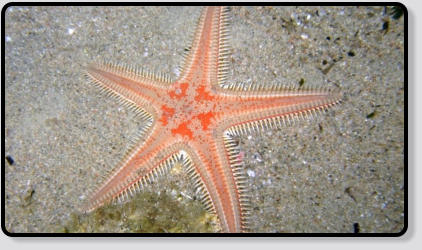
Description
Astropecten aranciacus, the red comb star, is a sea star of the family Astropectinidae. It is native to the east Atlantic Ocean (Portugal to Angola)
and Mediterranean Sea.
This starfish has superomarginal plates equipped with 1 to 3 small spines and inferomarginal plates with long, pointed, strong, regularly arranged
spines. The inferomarginal spines have reddish-orange colour at the base and yellowish or white colour towards the tip. It is rugged with normal
size disc and pointed arms. The colour of the aboral side is given by a succession of paxillae (from the top they look like round points) with upper
extremity red-orange in various combinations with paxillae with upper extremity grey or beige. The superomarginal plates are usually grey or
beige homogeneous. This is the largest species of Astropecten in the Mediterranean Sea, with a maximum diameter of 55 centimetres (22 in),
although it usually measures about 30 cm (12 in).
Astropecten aranciacus lives very near the coast, and at low tide it buries itself in the sand, showing only the centre of its upper side which is
swollen in the form of a cone. This cone acts like a sense organ. When it is touched, the cone contracts and the starfish buries itself on the sand
again. Then at high tide, the starfish reappears on the surface of the water. It buries itself in the sand to shield parts of its body from the rays of
the sun, especially the bottom surface which has no coloured pigment and is therefore particularly sensitive
Animalia
Scientific classification
Kingdom:
Phylum:
Echinodermata
Class:
Asteroidea
Order:
Forcipulatida
Family:
Asteriidae
Genus:
Coscinasterias
Species:
C. Tenuispina
Binomial name (link Wikipedia)




Blue Starfisch
Coscinasterias Tenuispina
Dornenseestern
Estrella de Muchos Brazos
Blauwe Zeester

Description
Coscinasterias tenuispina is a starfish in the family Asteriidae. It is sometimes called the blue spiny starfish or the white starfish. It occurs in
shallow waters in the Atlantic Ocean and the Mediterranean Sea.
Coscinasterias tenuispina has from 6 to 12 arms (usually 7), often of varying lengths, and grows to 20cm (8in) in diameter. It is a creamy, slightly
bluish colour, variously blotched with brown, and is rough textured with short spines.
The range of Coscinasterias tenuispina includes the Mediterranean Sea, France, Spain and Portugal, the Azores and other Atlantic Islands,
Bermuda, Cuba and the American coast between North Carolina and Santos, Brazil. It is found on the lower shore and down to a depth of about
50m (160ft). A number of divergent populations of the starfish in the Atlantic and Mediterranean are believed to be deserving of being recognized
as sub-species. The female population of the starfish in the Mediterranean is larger than that of the males.
Animalia
Scientific classification
Kingdom:
Phylum:
Echinodermata
Class:
Asteroidea
Order:
Spinulosida
Family:
Echinasteridae
Genus:
Echinaster
Species:
E. Sepositus
Binomial name (link Wikipedia)




Red Starfisch
Echinaster Serpositus
Purpurseestern
Estrella de Mar Espinosa
Rode Zeester
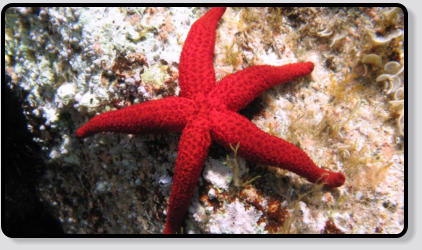
Echinaster sepositus, the Mediterranean red sea star (sometimes only red sea star, but this name is also used for other species), is a species of
starfish from the East Atlantic, including the Mediterranean Sea.
E. sepositus has five relatively slender arms around a small central disc. It usually has a diameter of up to 20 cm (8 in), but can exceptionally
reach up to 30 cm (12 in). It is a bright orange-red in colour, and has a soapy surface texture unlike superficially similar Henricia starfish (another
somewhat similar species from the same region is Ophidiaster ophidianus). The surface is dotted with evenly spaced pits from which the animal
can extend its deep red gills (papullae).
E. sepositus is found in the East Atlantic north of the Equator, including the Mediterranean Sea where it is one of the most common starfish
(although virtually absent from some localities). Its northern limit is the English Channel, but only on the French side. It is found at depths of 1 to
250 m (3–820 ft) in a wide range of habitats, including rocky, sandy and muddy bottoms, and sea grass meadows (Posidonia oceanica and
Zostera)
Description
Animalia
Scientific classification
Kingdom:
Phylum:
Echinodermata
Class:
Asteroidea
Order:
Valvatida
Family:
Ophidiasteridae
Genus:
Hacelia
Species:
H. Attenuata
Binomial name (link Wikipedia)




Orange Starfisch
Hacelia Attenuata
Oranger Seestern
Estrella Naranja
Oranje Zeester
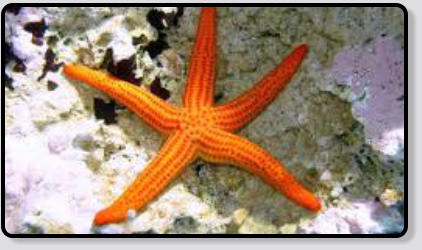
Hacelia attenuata is a species of sea star. The type species of the genus Hacelia, it was described by John Edward Gray in 1840. It is found in
the Mediterranean Sea.
No further information available on Wikipedia.
Description
Animalia
Scientific classification
Kingdom:
Phylum:
Echinodermata
Class:
Asteroidea
Order:
Forcipulatida
Family:
Asteriidae
Genus:
Marthasterias
Species:
M. Glacialis
Binomial name (link Wikipedia)




Spiny Starfisch
Marthasterias Glacialis
Eisseestern
Estrella Espinosa Común
Zwarte Zeester
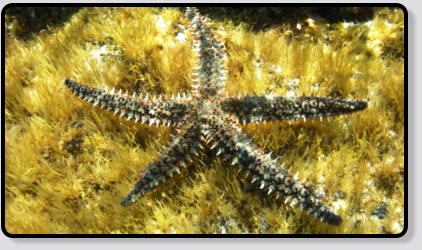
Marthasterias is a genus of starfish in the family Asteriidae. It is monotypic and the only species in the genus is Marthasterias glacialis, commonly
known as the spiny starfish. It is native to the eastern Atlantic Ocean.
Marthasterias glacialis is a fairly large starfish with a small central disc and five slender, tapering arms. Each arm has three longitudinal rows of
conical, whitish spines, usually with purple tips, each surrounded by a wreath of pedicellariae. The background colour is variable and may be
brownish or greenish-grey, tinged with yellow or red and sometimes with purple at the tips of the arms. This species can grow to 70 cm (28 in) but
a more usual size is 25 to 30 cm (10 to 12 in). It is sometimes confused with the northern starfish Leptasterias muelleri.
Marthasterias glacialis is native to the eastern Atlantic Ocean. Its range extends from Iceland to the Azores and the Mediterranean Sea, and it
has been observed in South Africa. Around the British Isles it is limited to the western side of Scotland, Wales, the western part of southern
England and most of Ireland. Its depth range is subtidal down to about 200 m (656 ft) and it is found on both sheltered muddy substrates and on
rocks.
Description
Animalia





Harry van Goor 2016
source: Wikipedia, the free encyclopedia


Categories: Starfisch






Scientific classification
Kingdom:
Phylum:
Echinodermata
Class:
Asteroidea
Order:
Valvatida
Family:
Ophidiasteridae
Genus:
Narcissia
Species:
Narcissia
Narcissia Canariensis
Binomial name




Canary Starfisch
Narcissia Canariensis
Kanarenseestern
Estrella de Mar
Canarische Zeester
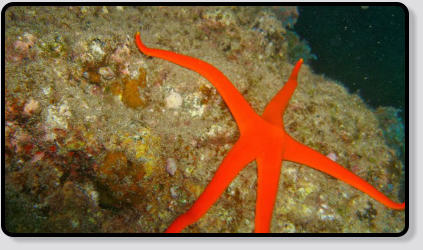
Typical Canarian Starfisch around waters of the Canary Islands.
No further information available on Wikipedia.
Description
Animalia


Scientific classification
Kingdom:
Phylum:
Echinodermata
Class:
Asteroidea
Order:
Valvatida
Family:
Ophidiasteridae
Genus:
Ophidiaster
Species:
O. Ophidianus
Ophidiaster Ophidianus
Binomial name




Purple Sea-Star
Ophidiaster Ophidianus
Rotvioletter Seestern
Estrella de Mar Serpiente
Paarse Zeester
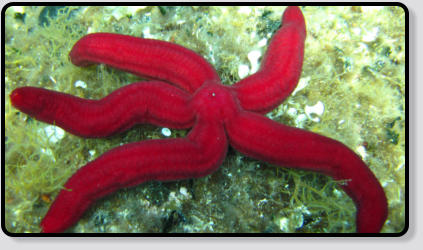
No further information available on Wikipedia.
Description
Animalia


Scientific classification
Kingdom:
Phylum:
Echinodermata
Class:
Ophiuroidea
Order:
Ophiurida
Family:
Ophiodermatidae
Genus:
Ophioderma
Species:
O. Longicaudum
Ophioderma Longicaudum
Binomial name




Annulated Brittle Star
Ophiure
Geringelter Schlangenstern
Ofiura
Slangster
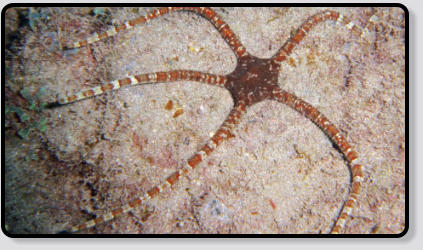
No further information available on Wikipedia.
Description
Animalia

